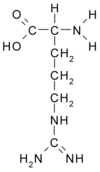Byline: P. Kumar, A. Kumar, S. Tiwari
It has become obvious that L-arginine, normally considered a nonessential amino acid, plays a critical role in cardiovascular protection and immune system support[1]. Under the conditions of stress, sickness or injury, this important amino acid is changed into a conditionally essential one, which means that supplemental L-arginine must come from the diet. L-arginine reduces the risk of heart diseases[2] by producing nitric oxide and acts as a powerful anticoagulant that helps to prevent blood platelets from clumping together[3]. A number of studies have been performed regarding the effect of L-arginine on blood pressure, myocardial ischemia and atherosclerosis[4],[6]. Very few studies are available showing the effect of L-arginine on serum cholesterol[7]. Present study was designed to assess that oral L-arginine have any effect on normal and hypercholesterolemic rabbits.
This study approved by the local ethics committee has been conducted in 24 albino rabbits of both sexes (three males and three females from each group) weighing between 1.2 and 1.5 kg to elucidate the effect of L-arginine on serum cholesterol level. Blood samples of 2 ml from each rabbit were collected from marginal ear vein. Total serum cholesterol level of each rabbit was estimated at the start and at the 16th week of study using multichannel autoanalyzer (Hitachi 911) and using kits from Boehringer Mannheim (Italy).
Rabbits were divided into four groups (n = 6) (two control groups and two experimental groups) and housed under standard laboratory conditions at ambient temperature (22-28 oC) with 12 h day/night cycle. Rabbits were allowed to take standard rabbit feed (Amrut Maharastra, India) and water was provided ad libitum .
Each rabbit from control Group I was kept on standard rabbit feed (SRF) 120 g/day in divided doses. L-arginine 100 mg/kg, body weight per day was added along with 120 g SRF to experimental Group I. Rabbits of control Group II were fed with hyperlipidemic diet (1% cholesterol + 3% coconut oil) along with 120 g SRF. L-arginine 100 mg/kg, body weight was added to hyperlipidemic diet with 120 g SRF in rabbit of experimental Group II. Above protocol was maintained for 16 weeks. After 16 weeks, the serum cholesterol levels from all the four groups were estimated [Table:1].
All the results were analyzed using the Student's paired ' t ' test and P< 0.01 was taken as significant. The total cholesterol level was similar in all groups of rabbits used in the study. The increase of total cholesterol in control Group II at the 16th week was 3 to 3.5 times the baseline value because of high-cholesterol diets. The total serum cholesterol level at the 16th week in experimental Groups I and II showed significant increase as compared to their corresponding controls at the 16th week.
The values obtained from our study were compared with the published data[4],[5],[6] and were found to be in absolute disagreement because available studies showed that L-arginine is beneficial but our results showing that L-arginine increases serum cholesterol, which is not useful. But it seems that L-arginine induced increase in cholesterol may be essential for normal vasculature[8] that is responsible for the maintenance of blood pressure. To elucidate the mechanism responsible for increase in cholesterol after L-arginine supplementation requires further study. These findings suggest that L-arginine administration requires a lot of precautions.
References
1. Sunita Roy, Goutam Roy, Mishra SC, Raviprakash V. Role of nitric oxide in central regulation of humoral response in rats. Indian J Pharmacol 2000;32:318-20.
2. Carrier M, Khalil A, Tourigny A, Solymoss BC, Pelletier LC. Effect of L-arginine on metabolic recovery of the ischemia myocardium. Ann Thorac Surg 1996;61:1651-7.
3. Kurose I, Wolf R, Grishan M.B, Garnger DN. Modulation of ischemia/reperfusion-induced microvascular dysfunction by nitric oxide. Circ Res 1994;74:376-82.
4. Demougeot C, Prigent-Tessier A, Marie, Berthelot A. Arginine inhibition reduces endothelial dysfunction and blood pressure rising in spontaneously hypertensive rats. J Hypertens 2005;23:971-8.
5. Peng W, Hucks D, Priest RM, Kan YM, Ward JP. Liegustrazine- induced endothelium- dependent relaxation in pulmonary arteries via an NO mediated and exogenous L-arginine dependent mechanism. Br J Pharmacol 1996;119;1063-71.
6. Dhawan V, Handu SS, Nain CK, Ganguly NK. Chronic L-arginine supplementation improves endothelial cell vasoactive functions in hypercholesterolemic and atherosclerotic monkeys. Mol Cell Biochem 2005;269:1-11.
7. Girouse I, Kurowsko EM, Carroll KK. Role of dietery Lysine, Metheonine and arginine in the regulation of hypercholesterolemia in rabbits. J Nutr Biochem 1999;10:166-71.
8. William FG. Review of Medical Physiology. 21st ed. California USA: Mc Graw Hill Companies.Inc.; 2003.
COPYRIGHT 2005 Medknow Publications
COPYRIGHT 2005 Gale Group



